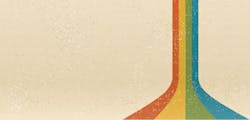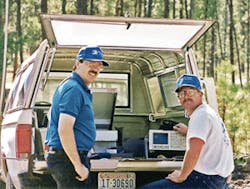Seeing Its Evolution Is Believing —
The optical time domain reflectometer (OTDR) is now 36 years old and aging gracefully.
While fiber optic cables had been installed in North America since 1977, the major fear was and still is How do we accurately locate a fault? This is the major reason that OTDRs are purchased. Fortunately, as the communications industry has matured, so has the OTDR. This article addresses how the OTDR has changed but also how it is used by manufacturers, end users, and contractors, to address new fiber optic technologies and test requirements.
Why Use It?
Today’s OTDRs address quality control (QC) and quality assurance (QA) for optical fibers and cables. Fiber and cable manufacturers make use of the OTDR’s QC features to perform attenuation and length measurements at a variety of wavelengths based on the type of fiber being tested. These tests are more common in factory settings, often in conjunction with optical switches to allow quick and efficient testing of large numbers of optical fibers.
As fiber counts in cables have increased, the level of automation has paralleled this growth, providing opportunities to increase the OTDR’s value to service providers by incorporating optical switches to monitor live and dark fibers.
The OTDR’s dominant role for service providers and contractors is in QA roles — which is far more extensive and complex than QC testing. Modern OTDRs must address multiple tests and measurement tasks focused mostly around attenuation, but as the critical nature of reflections and their impact on system performance increase, the OTDR is essential for these measurements. It must also be able to perform length measurements for approximate physical locations of events such as splice locations, physical fiber stresses (macrobends and microbends), passive devices such as splitters, and fiber breaks.
The OTDR is also the easiest instrument to use to measure component reflectance and span optical return loss (ORL) values. The importance of reflection testing cannot be overstated. Reflectance and ORL values are critical for achieving desired bit error rates as Fresnel reflections from connectors can disrupt the efficient operation of the laser diodes in fiber optic transmitters.
Transmitter manufacturers define the quality of signal based on the level of attenuation and the ORL values for fiber spans. A single contaminated connector can affect the component reflectance which in turn affects the span’s ORL value. Component reflectance and ORL testing should be mandatory requirements for all end-to-end OTDR tests.
New Challenges
As system data rates increase, the need for fiber characterization (FC) continues to challenge the industry. Already in cases where optical amplifiers are installed, identifying, locating, and re-terminating, high-loss connectors and splices is required due to higher reflection and attenuation issues with legacy terminations.
Older terminations often made decades ago were limited by 2 issues: 1.) fiber tolerances, and 2.) the type of polish on the connectors. Single-mode fiber tolerances continue to improve and include core, mode field diameter, and cladding diameters. Lesser known but just as important is core/cladding concentricity, which is how centered the core is within the fiber, and fiber ovality or how round the fiber is.
Legacy connectors such as first-generation single-mode Biconic, FC, D-4, and Diamond connectors, had either flat polishes or original physical contact (PC) polishes with reflectance levels of 30-40 dB. Even the improved super PC (SPC) polishes of the late 1990s with most ST and SC connectors have much greater reflectance levels (45 dB) than the 50-65 dB reflectance levels for today’s ultra physical contact (UPC) polishes and angled physical contact (APC) polishes.
Identifying high loss splices and connectors as well as high reflectance connectors can easily be performed by the OTDR. However if the readings are too high to meet today’s standards or system performance levels, these older pigtail terminations may have to be replaced with lower reflective polished connectors.
Which Came First:
The Chicken or the Egg?
Is the technology driving the development of improved OTDRs? Or are the users driving their needs? Each group will have their own perspectives. The manufacturers have done a great job at developing smaller, lighter, less costly instruments. They have done so while improving technical requirements: greater dynamic range, shorter and longer laser pulse widths, increased waveform and data storage, longer battery life, and interfaces for exporting data via Bluetooth or Wi-Fi. At the same time maintaining an instrument that is easy to operate.
Figure 1. Acceptance testing in the 1990s with mainframe OTDR.
OTDRs have also grown from AC powered mainframe OTDRs to handheld mini OTDRs. (See Figure 1.)
The development of modular OTDRs now called platform OTDRs (using the Telcordia terminology) allows for greater flexibility to add various optical tools such as optical power meters, visual fault locators, digital inspection scopes, and light sources to meet industry IEC, TIA, and Telcordia standards and recommendations.
Technology has also affected the role of the OTDR. As transmission rates increased the need to characterize a fiber for its chromatic dispersion and polarization mode dispersion values, the modular approach for OTDRs gave a tremendous degree of flexibility for more specialized testing.
Figure 2. Narrow band CWDM OTDR. (Photo courtesy of EXFO)
In addition, the greater implementation of cost-effective coarse wavelength division multiplexing (CWDM) required the OTDR to be able to find faults and measure fiber values at specific channels spaced in 20 nanometer increments per the ITU-T G.694 standard. (See Figure 2.)
For installers and contractors, quick and accurate documentation is essential for acceptance of the installation along with attenuation, reflectance, and distance measurements. Unless the operator understands the automatic functions of the instrument, there is greater likelihood of mistakes and/or changes to be required. One common example of making corrections would be to adjust the index of refraction (IOR) settings to match the cable’s sheath length as fiber length versus sheath length can be off as much as 5% in larger stranded loose tube cables.
GPS technology that can identify specific splice locations, cable slack, and route deviations, along with the ability to place icons on OTDR waveforms, has helped compensate for fiber IOR tolerances tremendously and for inclusion with as-built documents for known physical locations.
The industry continues to upgrade the OTDR to operate with auto functions that allow for quick multi-wavelengths testing, bidirectionally averaged waveforms, and trace analysis. The days of the traditional OTDR waveform has expanded to feature event tables and trace maps. Event tables identify each span and event with their distances, attenuation, and reflectance, along with icons to match the waveform for quick identification.
Setting up the OTDR with desired preset test conditions for maximum attenuation and reflection values will easily identify only those fibers that do not meet either component or span values and show pass/fail notations. These settings can be set automatically or customized for the span under test. For older installations, older settings can be used when needed.
What Is Old Is New Again
The role of the OTDR as a maintenance tool should not be overlooked. Already the ITU has developed several recommendations, such as L.41, for wavelength assignment for maintenance roles. These recommendations focus mostly on either the 1625 nm or 1650 nm for "out of band" testing. As these wavelengths are extremely sensitive to macrobends and microbends, service providers will also be able to identify possible problems unseen at the 1550 nm wavelengths. Trace overlays require the ability to recall stored traces to be overlaid with a new acquisition. Changes can be either automatically or manually detected. (See Figure 3.)
Figure 3. Trace overlay with 3 wavelengths, showing how longer wavelengths are more sensitive to fiber stresses.
Another application of the OTDR is the integration with optical switches. These allow an OTDR to function 24/7 while scanning and comparing stored waveforms either on live or dark fibers and are best used at hub sites where multiple cables can be monitored as desired.
The OTDR is an indispensable test and maintenance tool. It has grown with the fiber optic communication industry to address new technologies while maintaining its key role as the best instrument for troubleshooting optical fiber spans. For users, it is still key that the operators understand the abilities of the OTDR, and know how it can be used to address requirements of today’s fiber optic communication systems.
Light Brigade provides the fiber optic industry with educational courses and materials. All hands-on courses include OTDR training. Advanced courses such as Fiber Characterization, DWDM and FTTx for Installers and Technicians, use OTDRs and practices specific to the application. For more information, please visit www.lightbrigade.com.
Save
About the Author



